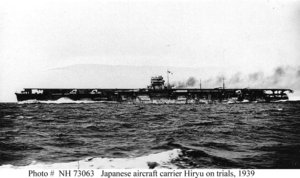Japanese aircraft carrier Hiryu
|
|

| |
| Career | 
|
|---|---|
| Ordered: | |
| Laid down: | 8 July 1936, Yokosuka |
| Launched: | 15 November 1937 |
| Commissioned: | 5 July 1939 |
| Fate: | Sunk by air attack in the battle of Midway on 5 June 1942 |
| Struck: | 25 September 1942 |
| General Characteristics | |
| Displacement: | 15,900 tons (standard), 19,500 tons (full load) |
| Length: | 728 ft 5 in (222 m) |
| Beam: | 70 ft (21 m) |
| Draught: | 24 ft 5 in (7.44 m) |
| Propulsion: | Geared steam turbines, 4 screws, 152,000 hp (113 MW) |
| Speed: | 34.5 knots (63.9 km/h) |
| Range: | |
| Complement: | 1,250 |
| Armament: | Twelve 5 inch (100 mm) guns Twenty-six 25 mm guns Fifteen 13.2 mm machine guns |
| Aircraft: | 73 |
Hiryu (Japanese: 飛龍, meaning "flying dragon") was a Soryu-class aircraft carrier of the Imperial Japanese Navy. She took part in the attack on Pearl Harbor that started the Pacific War and she was destroyed on June 5, 1942 by air attack in the Battle of Midway.
In 1941, commanded by Captain Kaku Tomeo, Hiryu was assigned to Carrier Division 2. On 7 December 1941 she was with the Strike Force in the attack on Pearl Harbor. She launched one wave of planes against the island of Oahu: ten Kates targeted Arizona, California, eight Kates targeted West Virginia, Oklahoma, and Helena and six Zeros attacked US air bases at Wheeler Field and Barbers Point.
From 21 December to 23 December she launched air strikes against Wake Island. In January 1942 she supported the invasion of Ambon in the Moluccas. On 19 February 1942, together with her sister ship Soryu she launched an air strike against Darwin, Australia.
In March 1942 she took part in the battle of the Java Sea, attacking Allied shipping at Tjilatjep and Christmas Island and sinking the Dutch freighter Poelau Bras. In April 1942 she took part in the Indian Ocean raid, striking Royal Navy bases at Columbo and Trincomalee Ceylon and helping to sink the cruisers Cornwall, Doresetshire, the aircraft carrier Hermes, and her escort destroyer Vampire.
On 19 April 1942 she pursued the US carriers Hornet and Enterprise after they launched the Doolittle Raid, but failed to catch them.
On 4 June 1942 she took part in the battle of Midway. At 04:30 she launched a strike against Midway Island, destroying planes and damaging installations. After Kaga, Soryu and Akagi were disabled by air attack at about 10:25, Hiryu was the only operational carrier left to the Japanese. She launched two waves of planes at 10:50 and 12:45 against Yorktown, heavily damaging the American carrier (she was sunk later by I-158).
Hiryu_f075712.jpg
While preparing to launch a third strike, Hiryu was attacked at 17:03 by thirteen dive bombers from Enterprise. She was hit by four bombs, three on the forward flight deck and one amidships beside the bridge. The explosions started fires among the aircraft on the hangar deck. Although Hiryu's propulsion wasn't affected, the fires could not be brought under control. At 21:23 her engines stopped and at 01:58 a major explosion rocked the ship. The order to abandon ship was given shortly afterwards and the survivors were taken off by the destroyers Kazagumo and Makigumo. Admiral Tamon Yamaguchi and Captain Kaku remained on board as Hiryu was scuttled at 05:10 by torpedoes from Makigumo. She sank at 09:12, taking 35 men down with her (another 350 or so had been killed by the bombs, fires and explosions). Thirty-five were rescued by the US Navy and taken prisoner.
External links
- Tabular record of movement (http://www.combinedfleet.com/hiryu.htm) from combinedfleet.com (http://www.combinedfleet.com/)
- WW2DB: Hiryu (http://ww2db.com/ship_spec.php?ship_id=12)de:HIJMS Hiryu
